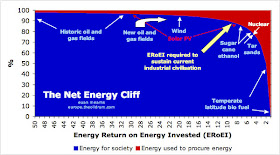A few puzzling problems exist in the shale-gas story:
- SECRECY:
Why is the industry so secretive about the composition of fracking fluids,
when there are only 2 companies which dominate the market
(Halliburton and Schlumberger) who share information, patents,
and scientists?
- LOW- YIELD FIELDS:
As illustrated by Deborah Rogers below
with a slide by Art Berman, only 1 well in 10 drilled in the Barnett
Shale in Texas is profitable. Why would they drill so many wells
where there is no gas?

- COST (Financial):
How can wells be profitable when each one requires so much
labor, specialized equipment, truck trips, and 80-100 tons of
specialty chemicals per frack?
Reports cite these costs at being between $2.3 - $7.6M per well, even for a dry hole:
- http://www.ohio.com/blogs/drilling/ohio-utica-shale-1.291290/anadarko-has-385-marcellus-shale-wells-five-in-utica-shale-1.346515
- http://marcellusdrilling.com/2011/09/how-much-does-it-cost-to-drill-a-single-marcellus-well-7-6m/
- COST (Energy):
EROEI is the Energy Return on Energy Invested. If you spend a gallon of gas to get 100 gallons, that's a good deal. But if you spend 1 gallon of gas to get 1 gallon, your net yield is zero.
When EROEI is 100:1, there is a big party.
When EROEI is 10:1, there is a small party.
When EROEI is 1:1 or below, investors are jumping out of tall office buildings in Dallas.
Consider all the energy which goes into fracking one shale gas well, the diesel fuel for thousands of truck trips, the energy which went into building the specialized drilling machines, the energy which went into manufacturing the specialty chemicals, etc., and the 9 dry holes for the 1 that pays out.
- Unexpected Chemicals Found:
Why are chemicals like acetone and methylene chloride (a common industrial solvent) showing up at well sites, when it has not been specifically or functionally been disclosed by FracFocus or any other industry source?- http://insideclimatenews.org/news/20121203/natural-gas-drilling-air-pollution-fracking-colorado-methane-benzene-endocrine-health-NMHC-epa-toxic-chemicals?page=show
- http://www.marcellus-shale.us/Stephanie-Hallowich.htm
- http://www.bloomberg.com/news/2012-12-03/hazardous-air-pollutants-detected-near-fracking-sites.html
- http://insideclimatenews.org/news/20121203/natural-gas-drilling-air-pollution-fracking-colorado-methane-benzene-endocrine-health-NMHC-epa-toxic-chemicals?page=show
- NO Profits:
Art Berman says no one is making any profits from shale gas:
What if a single theory helped to explain all of these?
Keep in mind that
- EVERY SHALE GAS WELL is also an INJECTION WELL, BY DEFINITION!
- Hallburton is also in the waste-disposal business
http://www.halliburton.com/en-US/ps/baroid/technical-challenges/drilling-waste-management.page - Our own USGS and National Labs are looking at storing* nuclear wastes in shale deposits:
http://www.usgs.gov/newsroom/article.asp?ID=364 - A really bizarre plan of technological geo-engineering where waste carbon is pulled from the atmosphere and from the exhaust of power plants and stored* in shale deposits: http://pubs.acs.org/doi/abs/10.1021/es401221j
- Note Well: in the above context, "storage" means "waste disposal".
What if a substantial amount of those 80 tons of chemicals needed per frack
were really re-purposed industrial wastes?
Est. 700 Million tons per year of Industrial Wastes in the US in 2013.
There were
- 4.5 million tons of industrial wastes in the US in 1945,
- 57 million tons in 1975
- 265 million tons of industrial wastes generated in the United States in 1990.
Source:
http://www.texascenter.org/almanac/Waste/INDUSTRIALCH9P1.HTML
Extrapolating this yields on the order of ~700 million tons per year in 2013.
So, consider this:
Could shale wells really be disposal wells, which sometimes strike golden gas?
Could this help explain why they drill so many wells when only 1 in 10 pay out?

No comments:
Post a Comment
Please enter your comment here. Spam and abusive posts will be removed.